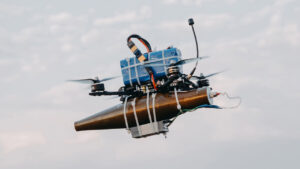On June 1, the Security Service of Ukraine (SSU) carried out a bold, unprecedented and coordinated drone strike deep inside Russian territory. Codenamed Operation Spider Web, the operation targeted four air bases striking more than 40 strategic aircraft including TU-95Ms, TU-22M3s and at least one A-50 aircraft.
Small Shrike FPV and Mavic drones were covertly smuggled into Russia and were launched from hidden compartments inside cargo trucks. The meticulously planned operation marks a significant milestone in Ukraine’s evolving asymmetric electronic warfare capabilities and signals a major vulnerability in Russia’s rear guard.
Since the Cold War ended, Russia used a layered defense system including missile-laden Pantsir and S-300 systems as an outer perimeter to keep threats miles away from its airbases. The Ukrainian operation smuggled the drones inside this perimeter and launched the drones within a mile of the airbases. This left only the Russian R-330Zh Zhitel- a mobile electronic warfare (EW) system that jams drone communications- for the Ukrainians to overcome.
Ukraine identified a weakness in the Zhitel that they exploited in this attack.
The first-person-view (FPV) drones used in the operation were remotely controlled through Russian mobile telecommunications networks, including 4G and LTE connections. The drones relied on a hardware-software system built around ArduPilot—an open-source autopilot framework. Each drone was integrated with a compact onboard Raspberry PI computer that was connected to a webcam and an LTE modem via Ethernet. The camera feed was used for visual navigation, while control signals were routed through ArduPilot’s UART interface.

Ukrainian Shrike
In addition to manual control, AI-assisted targeting appears to have been integrated into the drones’ attack logic. According to open-source intelligence and reporting, SSU teams trained the AI using visual profiles of the targeted aircraft which were preserved in Ukrainian aviation museums like the Poltava Museum of Long-Range and Strategic Aviation. They identified vulnerabilities in the airframes and trained the AI to attack those points.
The operation launched Mavic drones modified with encrypted control frequency amplifiers that acted as airborne signal boosters to counter the Russian Zhitels’ EW interference. Hundreds of Shrike 7 FPV drones carrying high-explosive warheads were launched simultaneously. The Shrikes utilized the Mavic signal boost to penetrate the airfield and get close enough for the AI targeting application to self-direct the drone the final short distance to the target – without any actions from a human pilot.
Ingenuity and AI rendered Russia’s electronic warfare systems ineffective and has all nations rethinking their defense systems. This operation will be seen as an inflection point in global strategic warfare.

Recent Comments